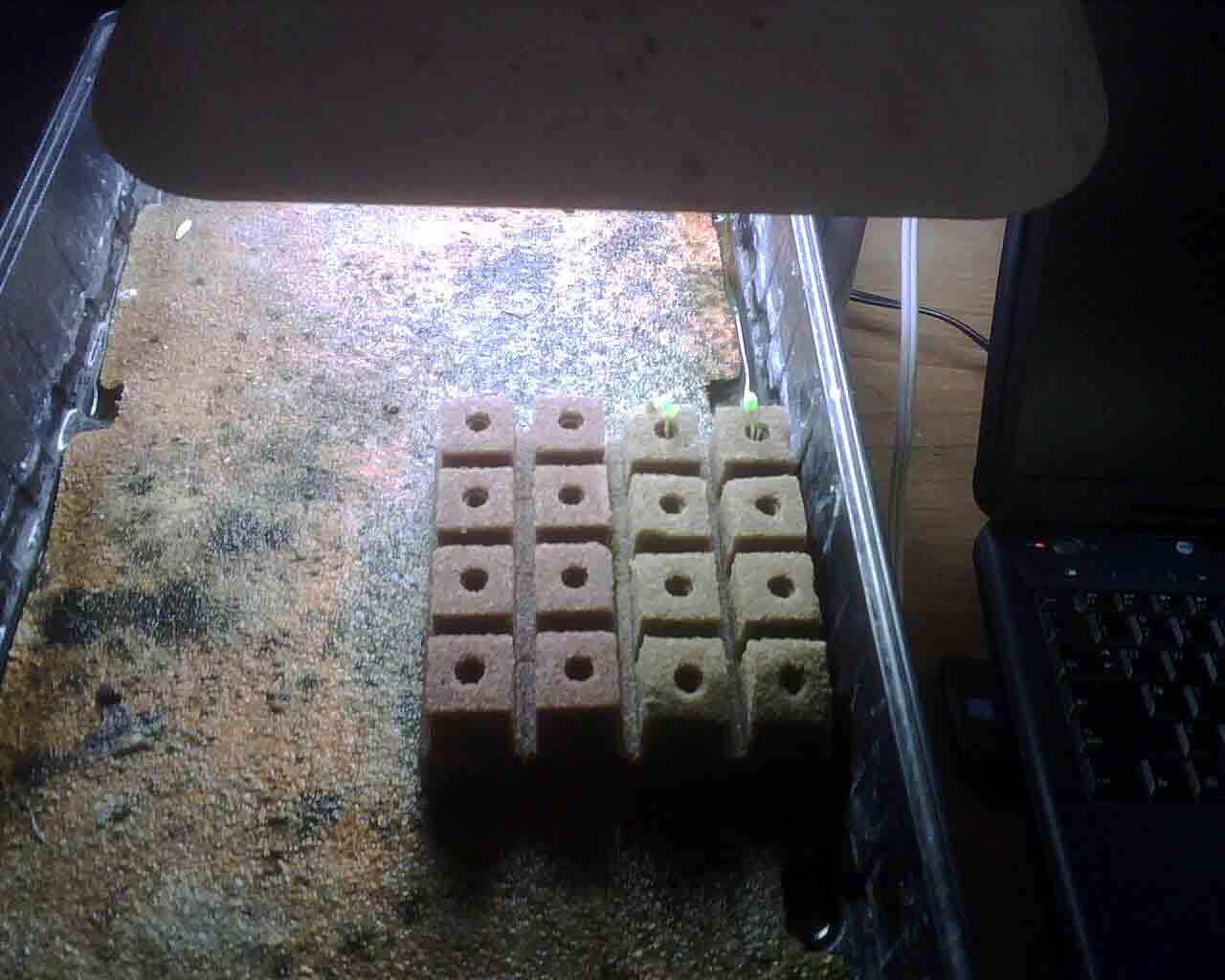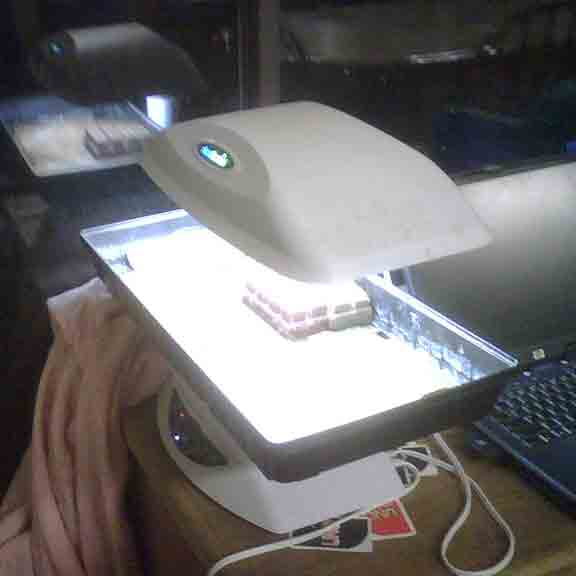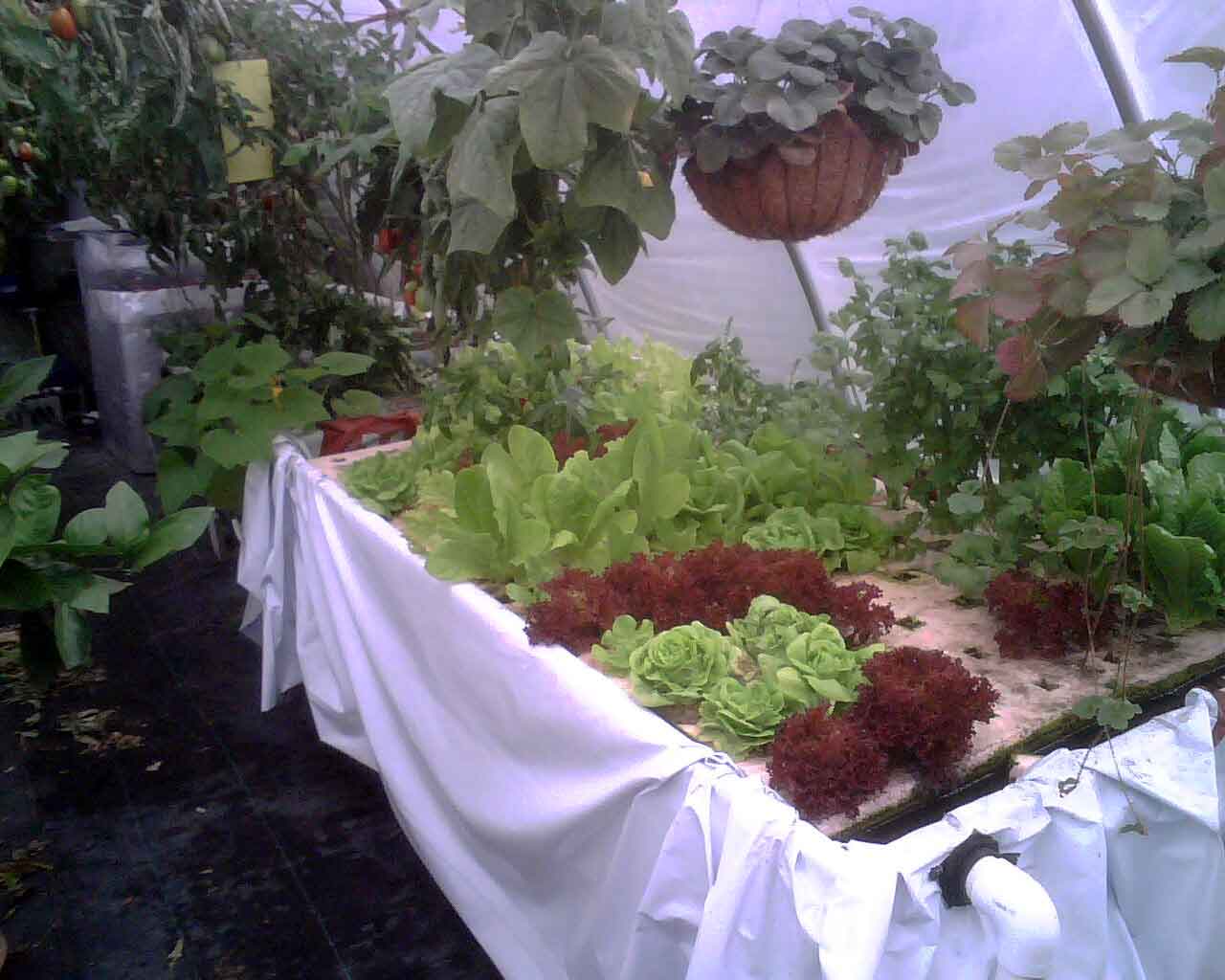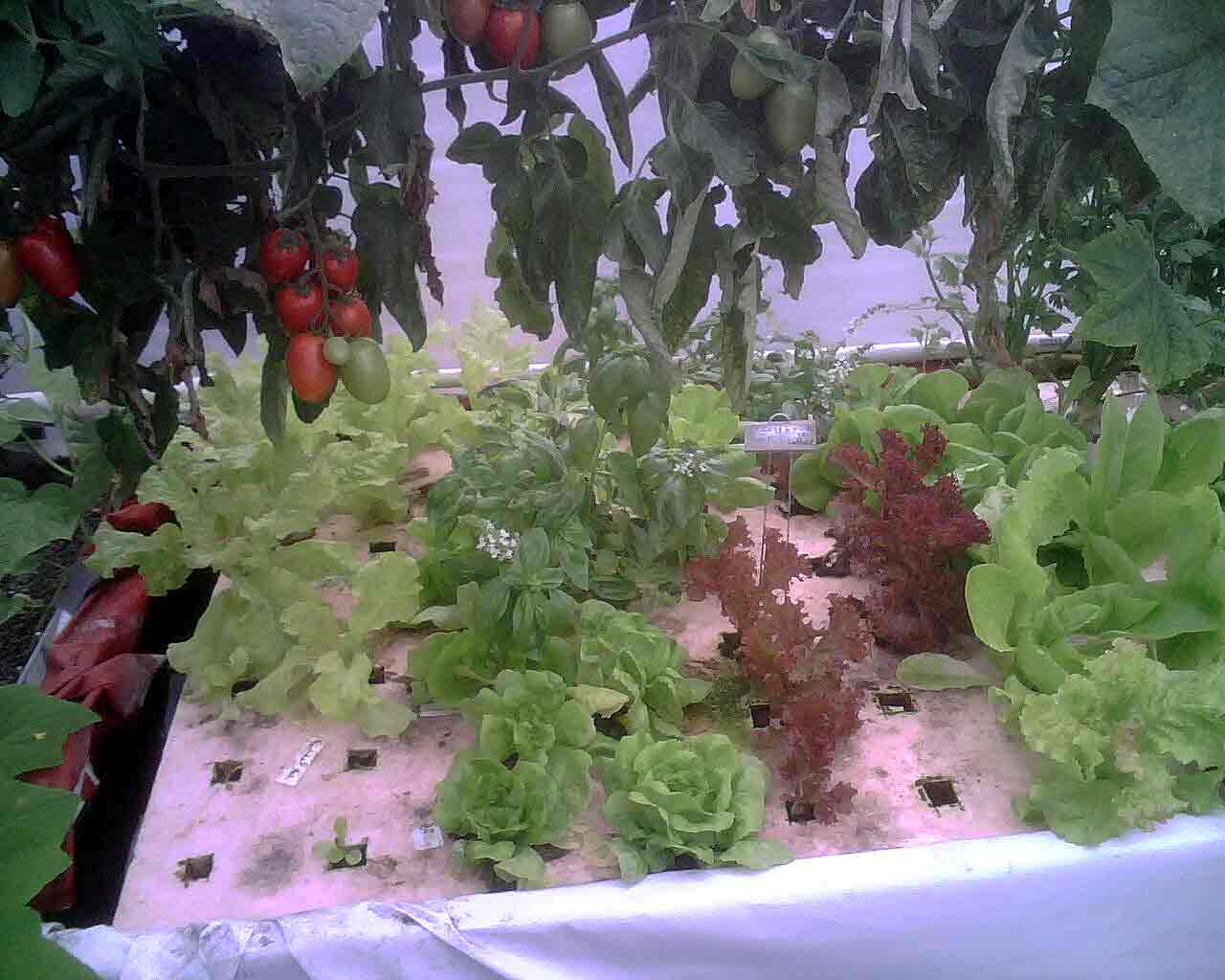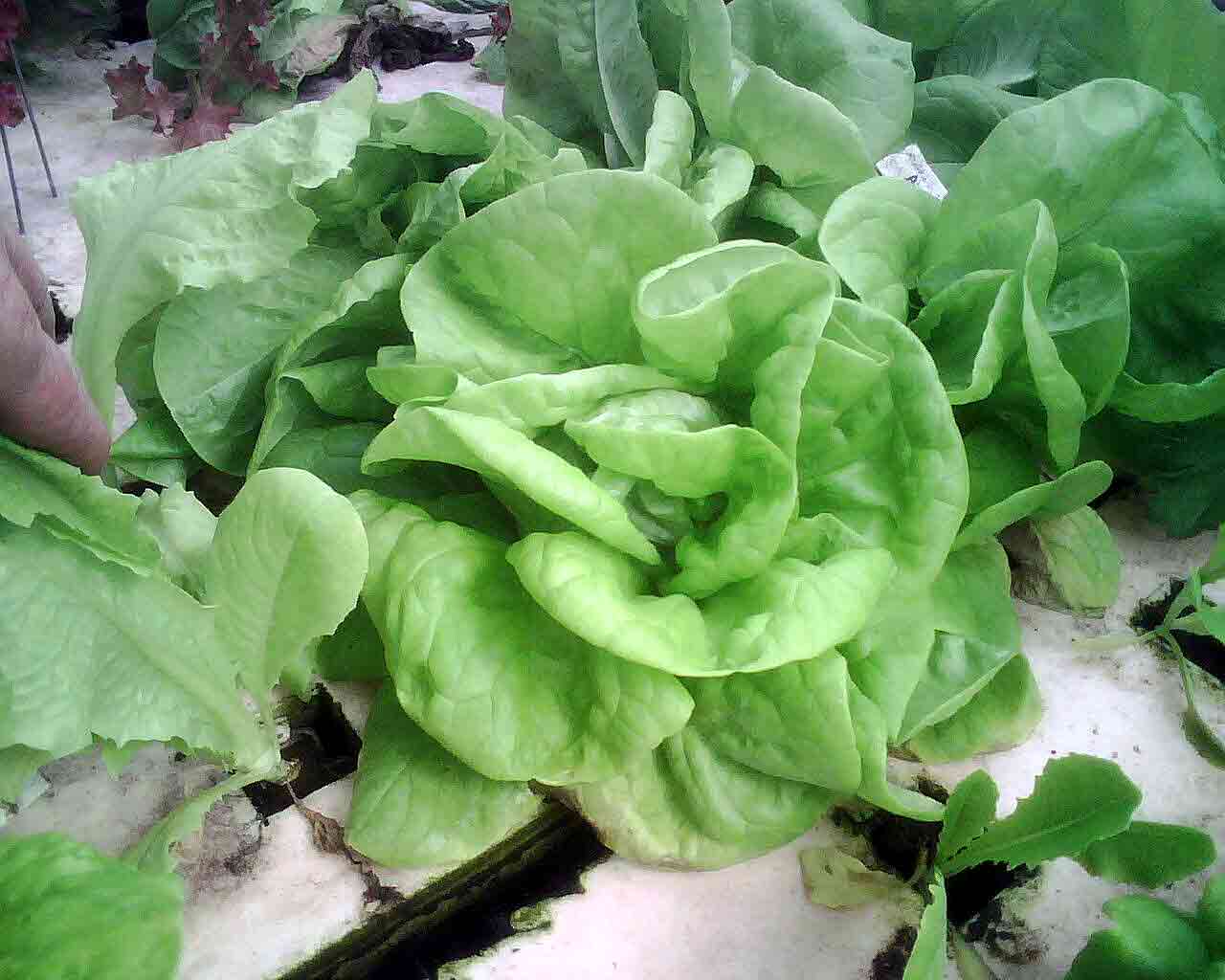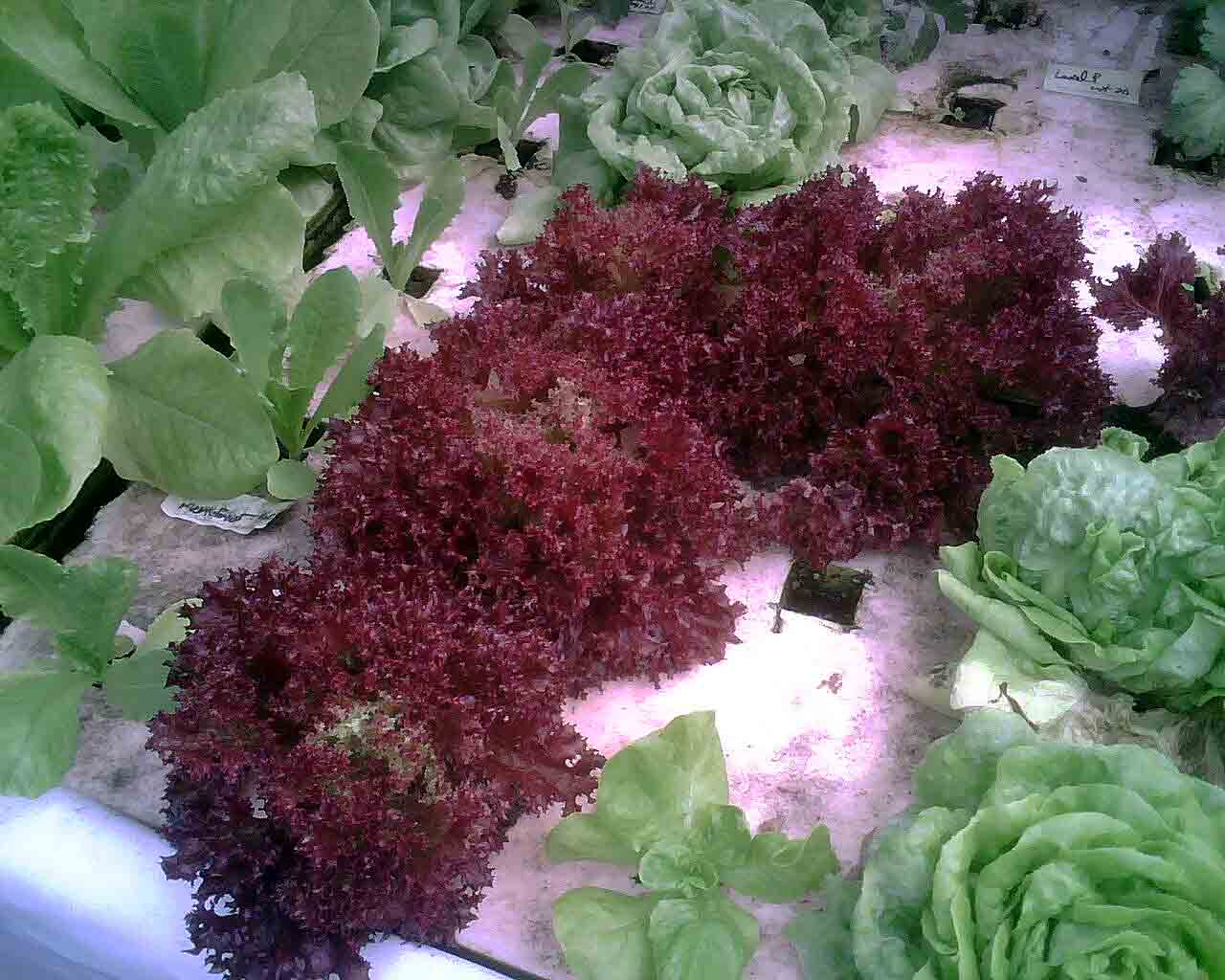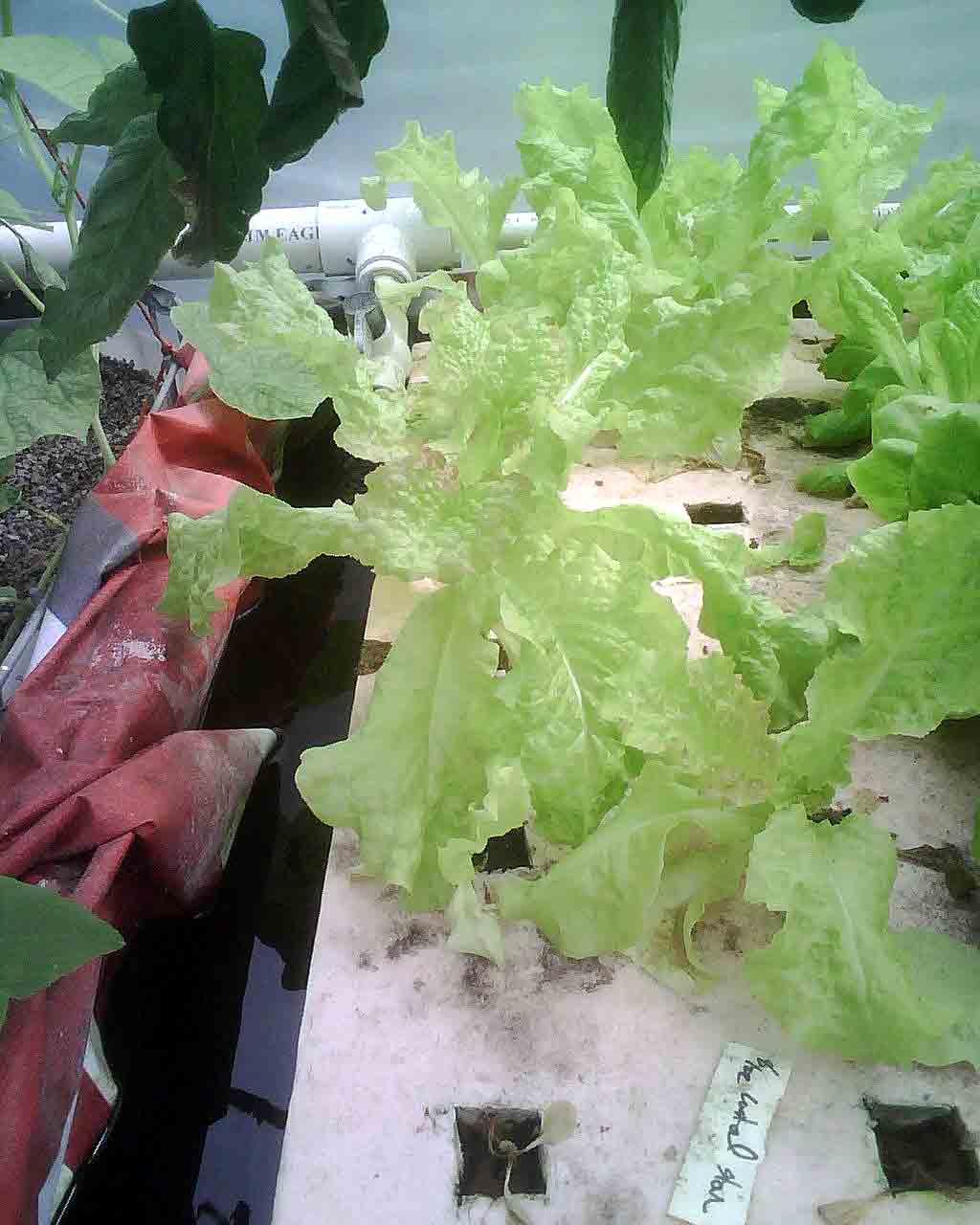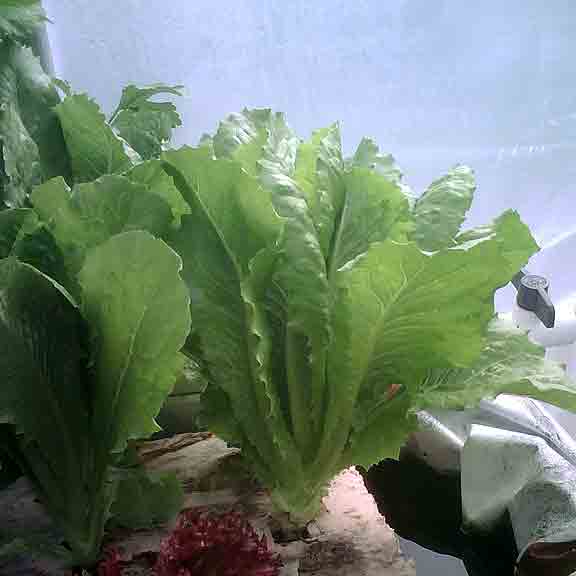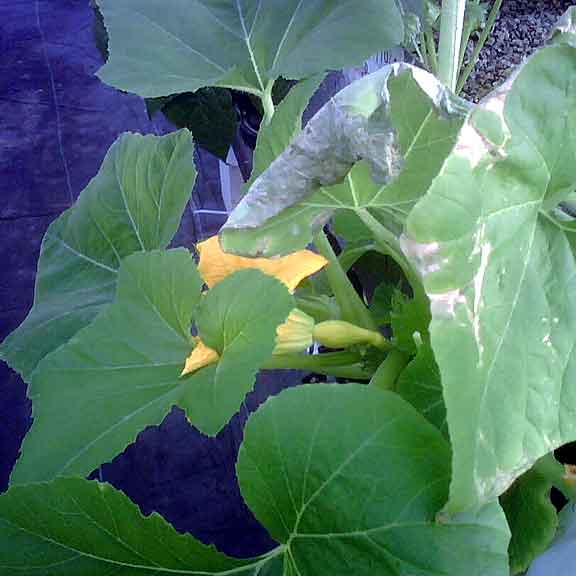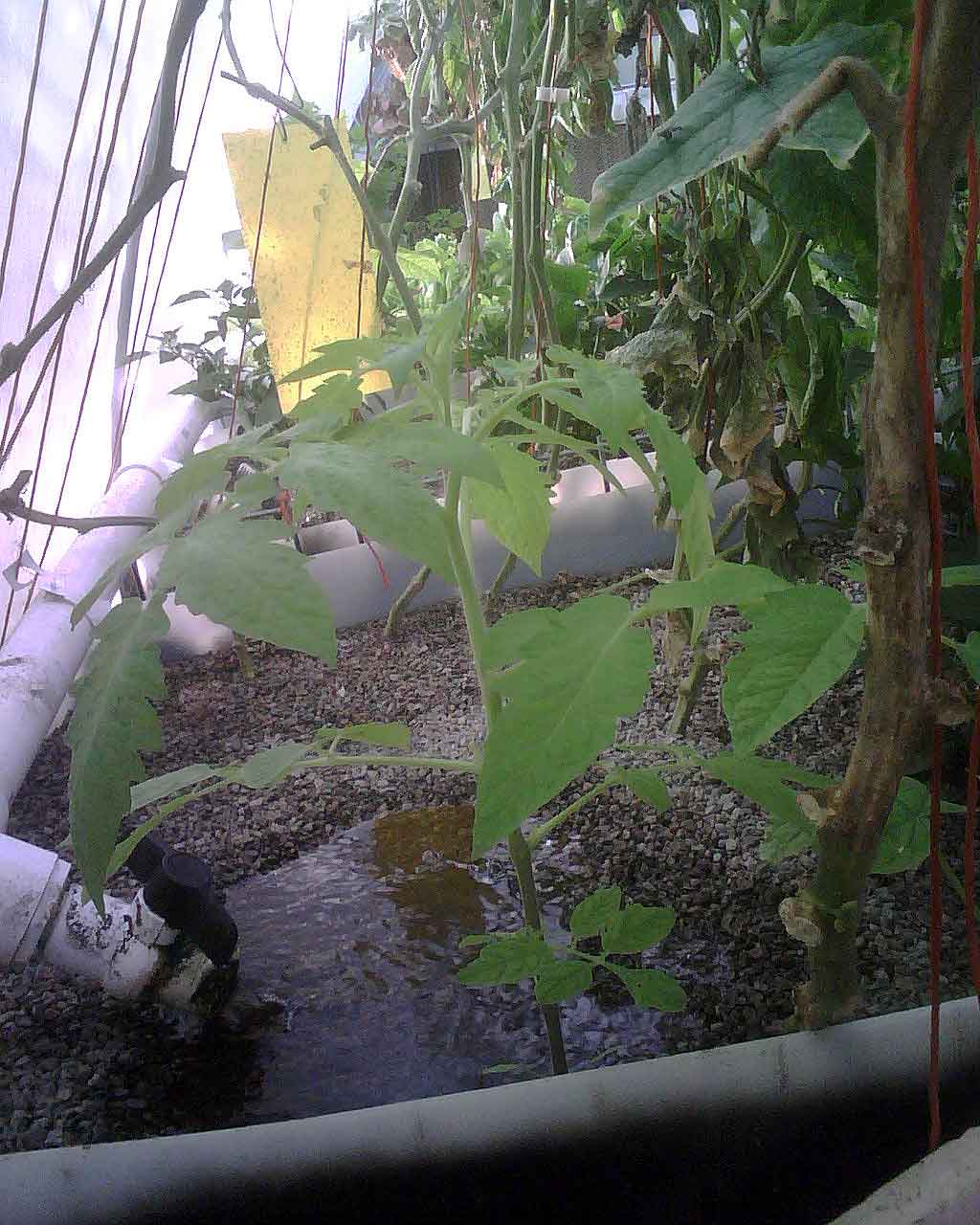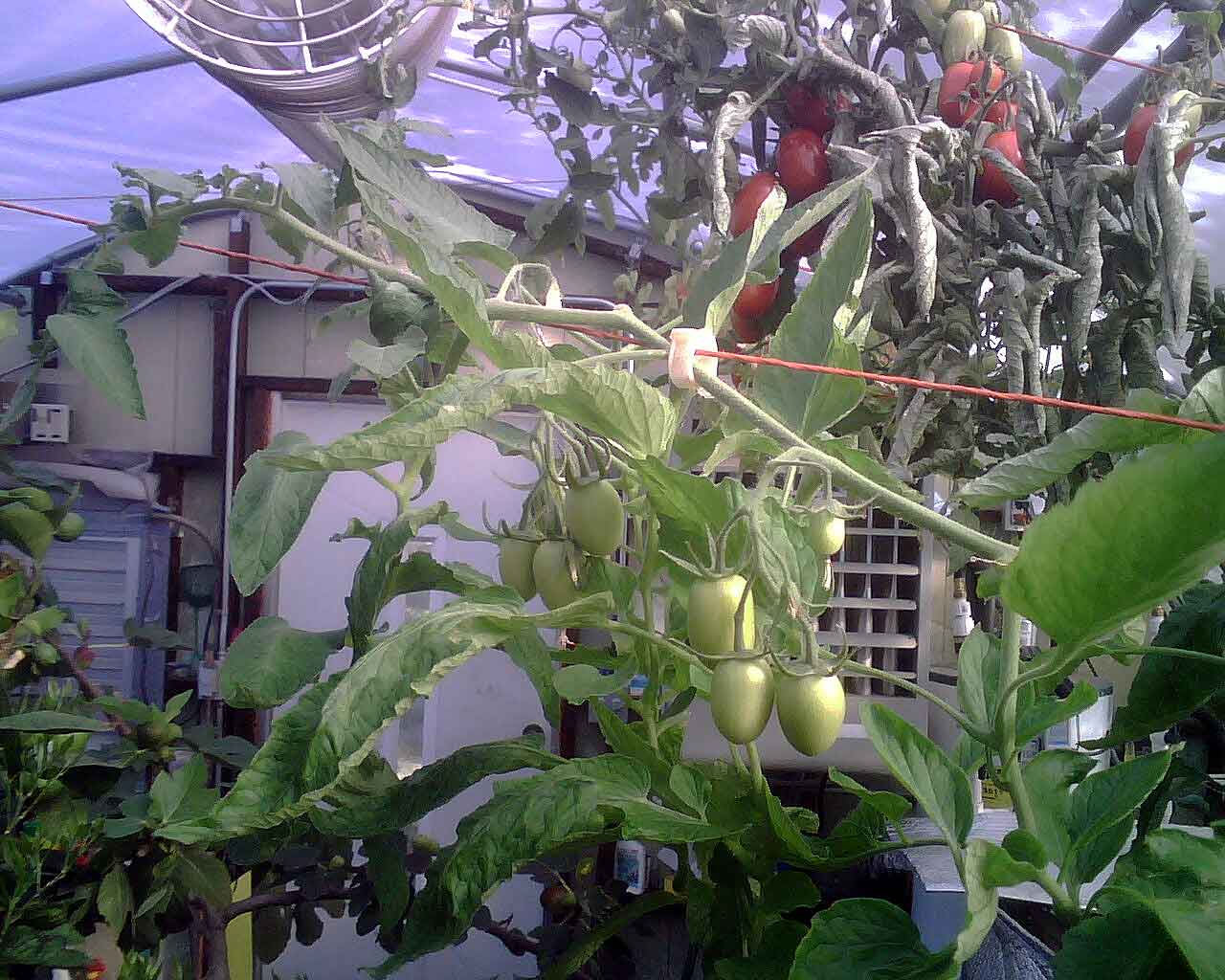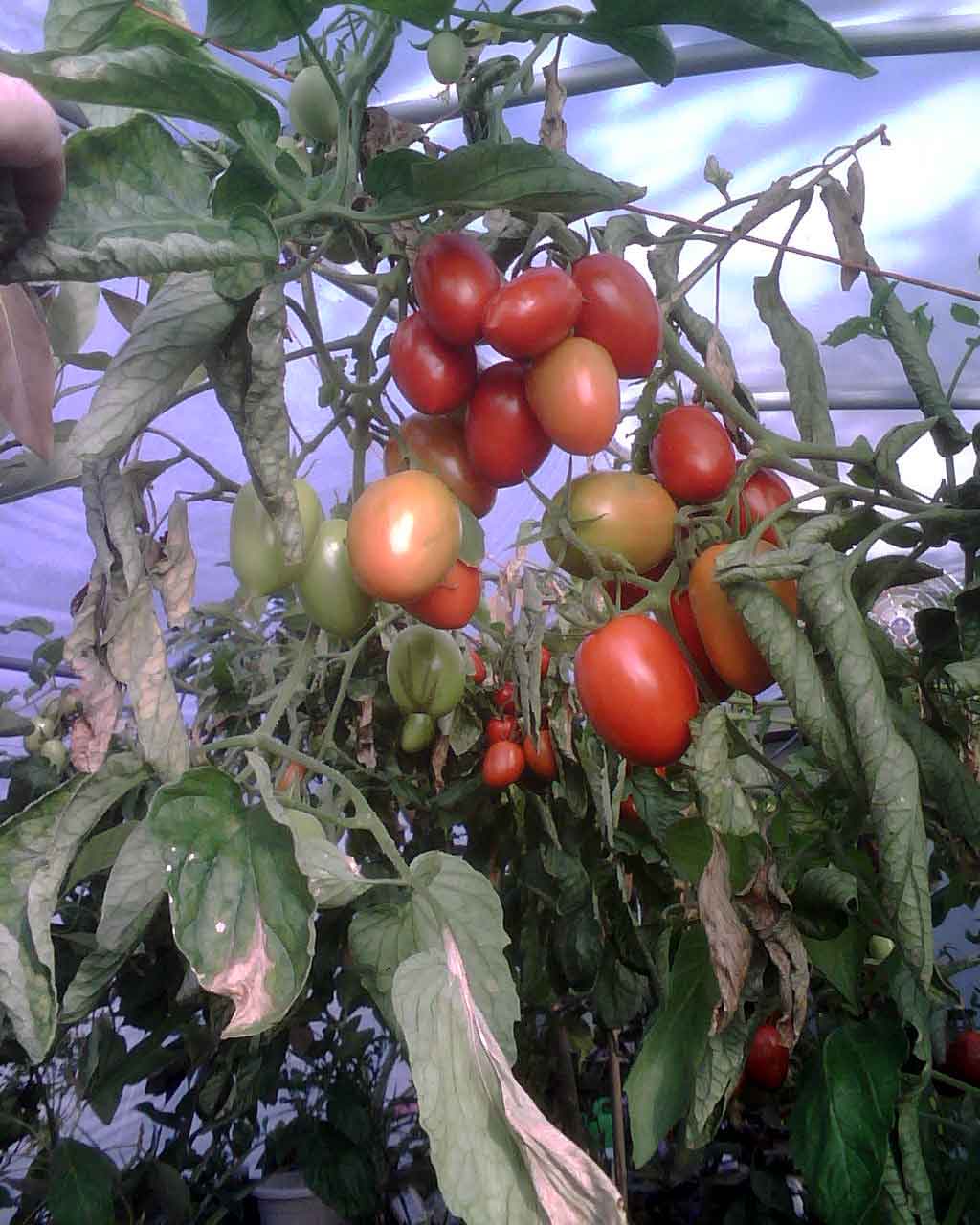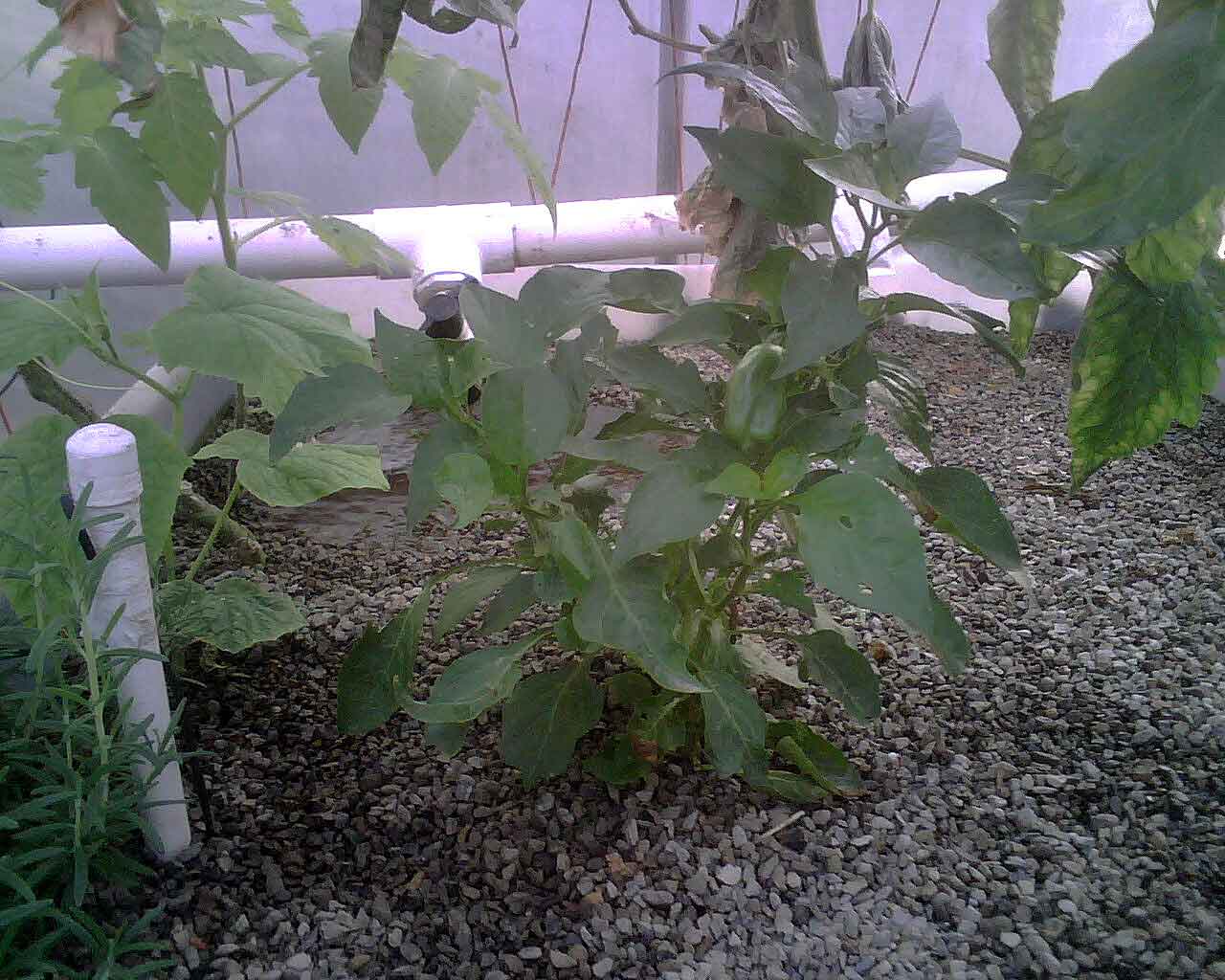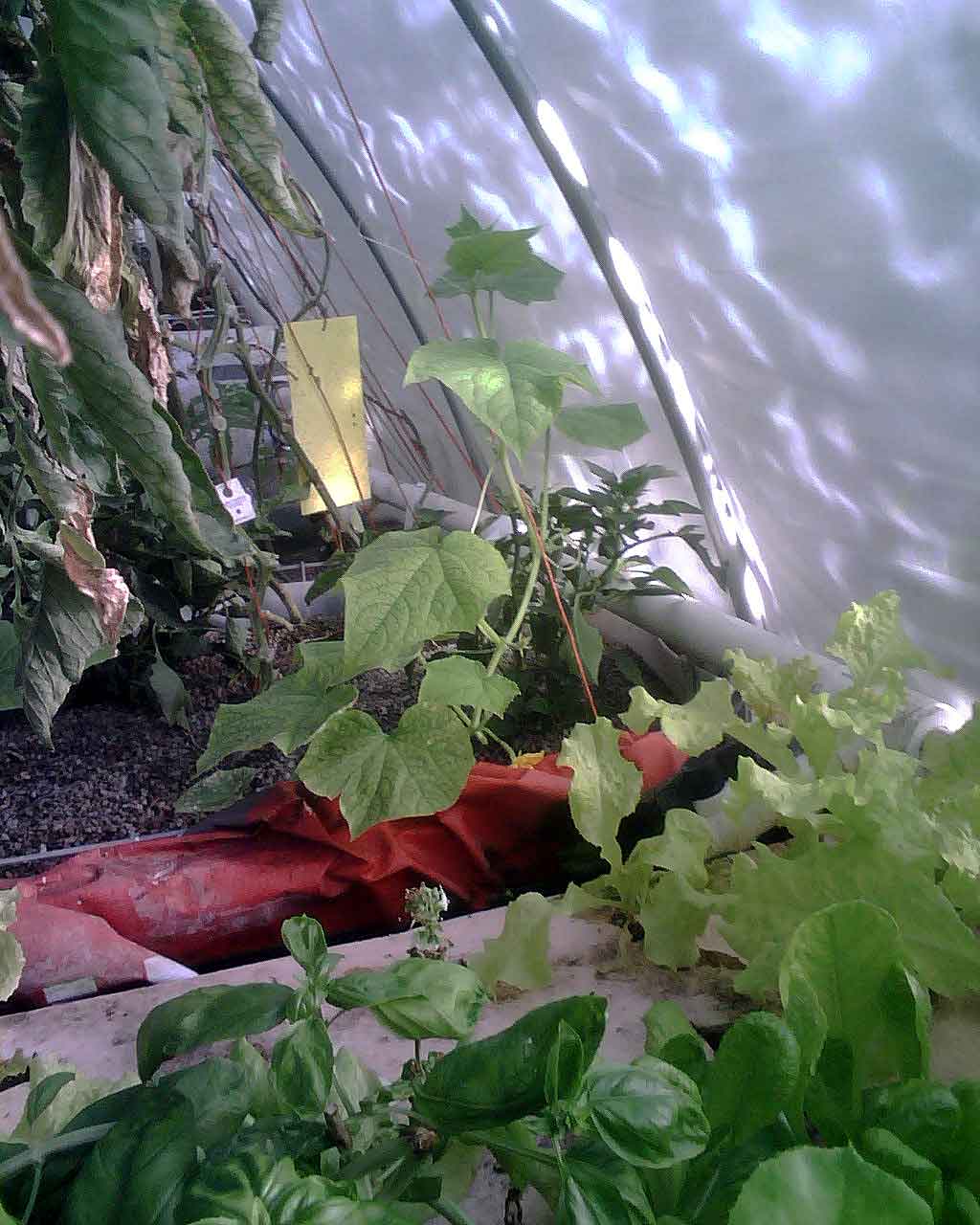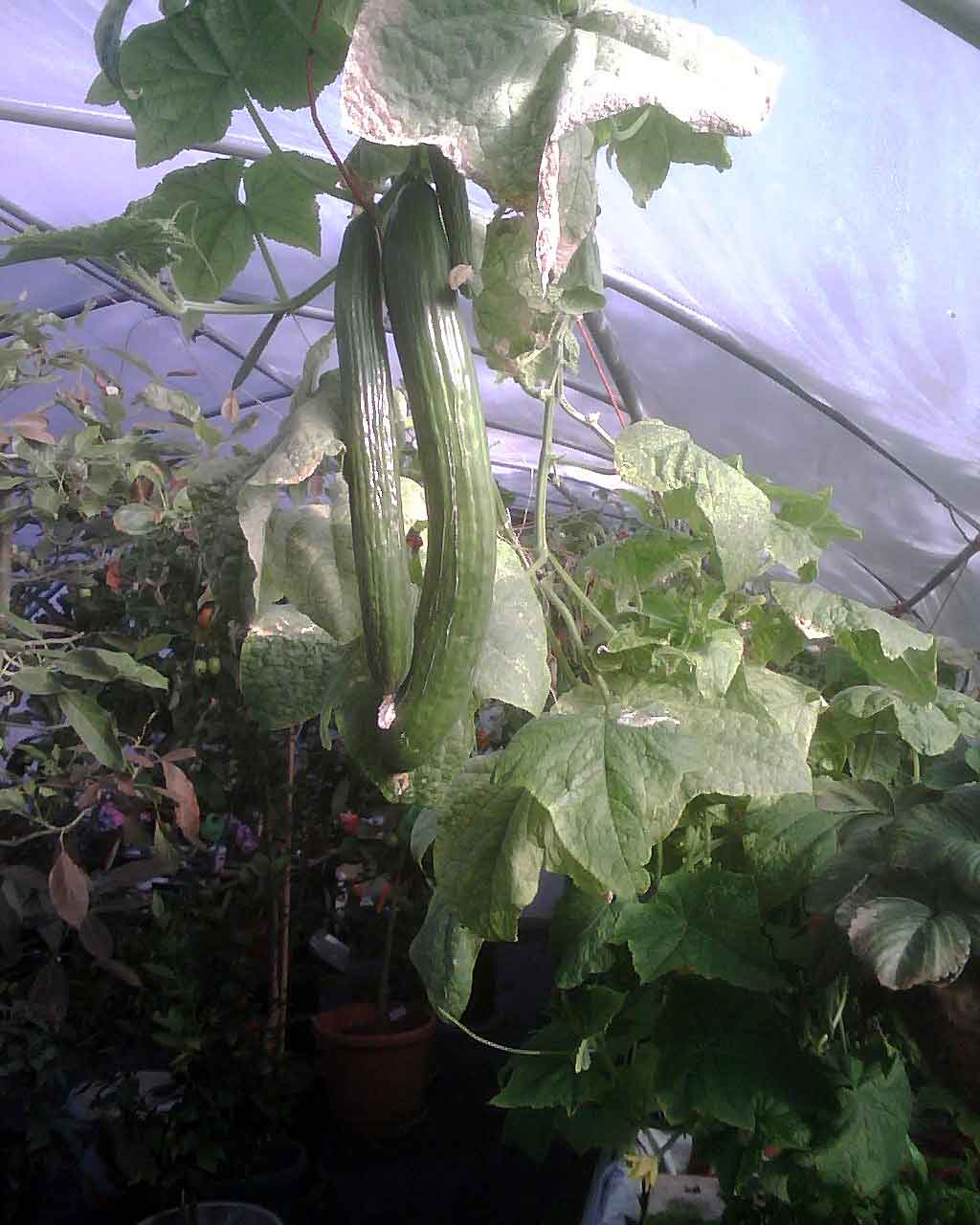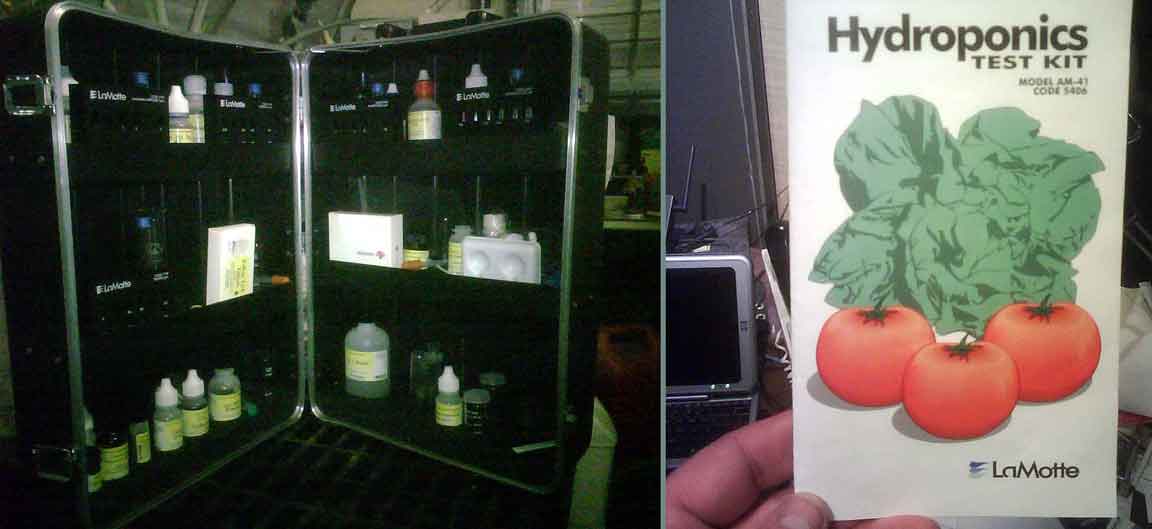Utah Aquaponics System - The Plants!
Back to Utah Aquaponics System Main Page
The system supports two types of plants: 1) Those grown in the gravel beds and, 2) Those grown in the Deep Water Culture (DWC) or Raft System. .
Detailed aquaponic system design information and plant and fish selection decisions can be found in our thread at AquaponicsHQ here: http://aquaponicsnation.com/forums/topic/802-utah-system-part-1-beginnings/
Starting Seedlings for Aquaponics.
The plants are started indoors in horticubes, and placed under lights that run 12 hours a day. The lights are an old AeroGarden system. The pump is disconnected and the timer just runs the lights for me. You could use fluorescent placed 4-6 inches above the tray as well. The seed are watered morning and night with system water, with extra water in the tray so they don't dry out. Most varieties are ready to move into the raft system in 1-2 weeks. Celery takes a little longer.
The seedlings are transplanted into the Raft system in a staggered fashion, about 6-8 starts a week. Notice in the picture below older lettuce and new transplants.
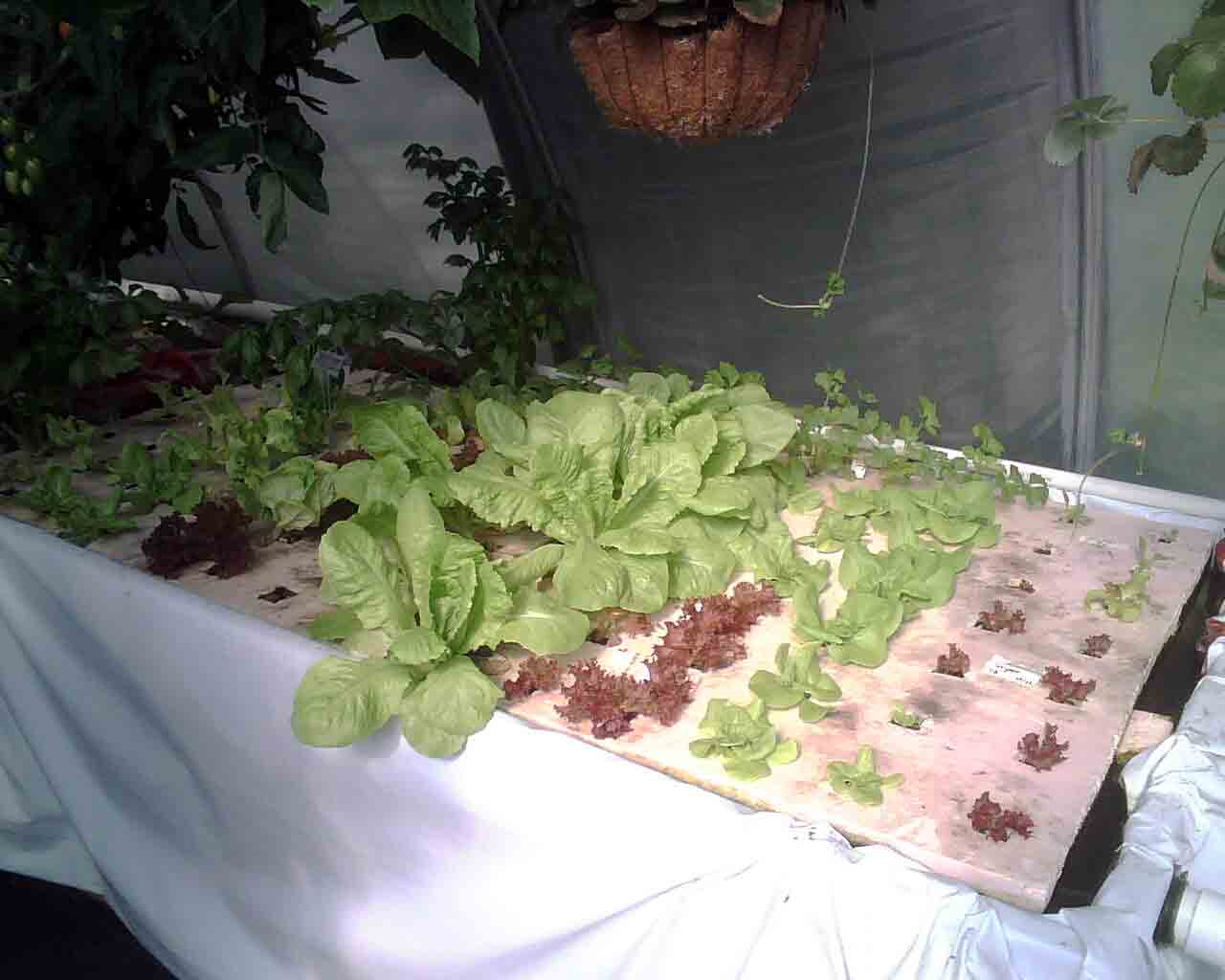
Another view - a month later.
Below, notice the roma tomatoes (that's part of the next installment)
Here are some of the varieties that I have grown in the DWC Raft. The lettuce varieties all do better when the water and air is cooler.
Butter head - Laural P
This is a nice full butter head, ready to harvest. This has been my best variety, Laurel P - the seeds came from Hydro-Gardens in Colorado. I've also tried Rex, which does almost as well. Both varieties go from seed to harvest in 8 weeks. They have had NO bug problems. You can see in the picture the most bottom leaf will brown. When you pull the head out of the raft, just peal off the bottom layer, remove the horticube, rinse and serve.

Celery - Utah
Believe it or not, Utah has a very prominent celery variety named after it. I think the technical designation is DX52-12 or improved DX52-70, my package doesn't say which, just Utah Celery. Celery takes longer, this celery is slow growing, it takes 4 months to mature. These stalks are 3 1/2 months old. We don't eat a lot, so 4-6 stalks a month are enough.
Red Leaf - Amadine
While the butter head and Romaine (or COS) types are the mainstay of our salad crops. I like to add a little color and variety. This variety has been ok, It's a little slower to grow than some of the others, and attracts small flying insects, which easily wash off. All of the lettuce from the system tastes great, no bitterness, even when it's hot. This is another commercial variety that I buy from Hydro-Gardens.
Romaine - Green Forest
I'm still working with this variety. As you can see, it bolts easily. It's a nice light green and delicate romaine that we like, but we tend to cut the leaves as the mature, rather than harvest it as a head. I'll see how it does this fall and winter as the weather cools off.
Romaine - Jericho
My first attempt in the hot summer and without the lighting for the seedlings didn't go well, but none of the romaine did well, they all bolted. My second go round using the lights, kept most varieties from bolting and this Jericho romaine is going to be a main stay. Its a traditional Romaine with thicker heavier leaves. It grows upright well and I harvest the whole head when it is ready. It is bug free and winner in my book. My original holes in the raft system are only 6 inches apart that is to close for the butter heads and leaf lettuce, but is just right for most of the Romaine and Celery.
Sweet Basil
I started this sweet basil back in March when I first brought up the system. The basil struggled for a long time. Everything I have read says that basil does well in aquaponics. I suspect that that will be true in an established system. I have 2 plants that we take cuttings from. We use very little so I will probably move one of these to the gravel beds and give it a more permanent home. Another variety may do better, I see some lower leaf disease that looks like powder mildew, not enough to treat or worry though. Likewise, no bug problems either. We will keep enough for the occasional meal that requires it.
That's it so for for the DWC tank. Later I'll post pictures and notes on what's in the gravel beds.
Gravel Bed System
Arp Rosemary
Rosmarinus Officinalis 'Arp' - I occasionally attempt a little italian cooking and many recipes call for fresh Rosemary, so a couple of months ago I purchased this from the local nursery and added it to the system.
Yellow Straight Neck Squash
Now that the summer is over and all my outside squash plants are frost bitten, I'm glad I started one plant in the system a few weeks ago. Here are the first fruit sets. The legal limit is one plant, any more and the neighbors get tired of us bringing squash over. Already there are 5 fruits set and they will be ready to pick 2 or 3 per week in just a few days.
New Roma Tomato Start - Directly Seeded
10' long Vine, Notice plant clip and twine
Ripe Roma Tomatoes
Roma are supposed to be a determinant variety, that is they grow like a bush and not as a vine. I've treated them like indeterminant, pinching off the secondaries and they are 10-15' long vines now, with full hands of tomatoes at each node. I had 6 plants and they are so prolific we have tomatoes everywhere, and give them away to family and neighbors. Adding calcium and Iron insures good fruit set (no pollination, just circulating fans that move the air), the older leaves will die back, probably potassium deficiency. I did these and an earl girl variety, both did well, but I favor the roma's for all around cooking and salad's the 1 early girl plant we use for sliced tomatoes.
California Wonder Bell Pepper
I moved 2 plants from the garden into the system for the winter. They produced well outside. I picked all the peppers, dug them up, washed the roots and leaves off (don't want extra bugs) and then buried them in the system, they have handled move well, flowering and setting fruit without delay.
New cucumber plant just started
Discover - European Burpless Cucumbers
This is a greenhouse variety that I purchased from hydro-gardens in Colorado. The single biggest challenge with cucumbers in the greenhouse is powdery mildew, this variety (and others) are resistant to powdery mildew. They still get it, but on older leaves after the cucumber at that node is harvested. With both Cucumbers and Tomatoes, you train the vine to a single leader, removing the secondary nodes, and after a node has produced fruit, you remove the leaves at the node. This variety has done very well. If the Iron or Calcium level are to low, then the new fruit shrivels. Once the fruit sets, it seems to grow fine, regardless of the other levels. The vines are 12-15' long and 9 months old. I've started 2 new plants to replace these. The vines are trained around the twine as they grow.
Aquaponic Plant Nutrient Deficiencies
In my system, I have to regularly add calcium, iron, Potassium and Magnesium.
Here are my log notes on what symptoms go with which deficiencies: ( have experienced and corrected all of these)
1) New leaves brown - Potassium
2) Young Leaves yellow (between the veins) with green veins - Generally Iron or Magnesium.
3) Older Leaves yellowing between - Generally Magnesium or Iron.
4) Growing tips, or new growth stunted and shrunken, or old leaves dry up - Nitrogen
5) fruit doesn't set, or small fruits shrivel and drop - Calcium or Iron
6) Tomatoes - blossom end rot - Calcium
7) Cucumbers - leaves scorched, browning around the edges - Potassium
Fruiting plants have the greatest deficiency tendencies. Green leafy plants seem to survive on lower levels.
Easy source of:
1) Magnesium - Epsom Salts/Magnesium Sulfate (grocery store) -
2) Potassium - Potash (garden store)
3) Chelated Iron - (garden store)
4) Calcium Nitrate - (mine came from greenhouse supplier 19% calc, 15% nitrate)
Calcium and Potassium can bind each other, so add these on different weeks.
I have found that my Nitrate level stays below 5 ppm and that while my fish are smaller, they don't produce enough nitrate, so In my aprox. 1000 liter fish tank - 1000 liter grow beds/raft system, I add 1 tablespoon of calcium nitrate every other or every third day. If I don't, all the small cucumbers on my 2 massive plants, shrivel and die.
I add 1 tablespoon of chelated Iron every other week. 1 tablespoon of Potassium and Magnesium every other week, unless I see plant problems.
My system is 6 months old and fruit shriveling of the cucs is the only problem I really see (calcium and iron). Everything else is doing well. We pick 18-24 large Roma tomatoes a week, about 1 head of lettuce daily, and 3-4 massive cucumbers weekly. Which is just right for our family.
Also, keeping your PH down (6.4-6.8) makes a big difference on what the plants can take up.
Of the additives, calcium, iron, magnesium are not generally toxic to fish in higher levels. Potassium can be, so it's the one I'm more careful with. My next purchase is a complete test kit so I can monitor the actual levels of all these nutrients. Right now I can monitor Nitrate and PH of course, and total dissolved solids. but none of the others.
Hydroponics Test Kit
I've ordered a test kit to be able to test my system and input water for these key macro and micro nutrients.
The kit was designed for hydroponics, which maintain levels 10-100x higher than ours.
1) PH - no brainer, I did it just to see if it came up with different result. My other test kit shows about 7.0, The electronic meter I have shows 7.0, this showed 7.0-7.2 (comparing colors in any of these tests can be tricky.) - (A man with one watch always knows what time it is, a man with two... well.)
2) Nitrate Nitrogen - It took me 3 times to get this one down. I found you have to dilute the sample 10 to 1 (the kit comes with de ionized water for this purpose). Then the sample showed 40-60ppm nitrate nitrogen. The other test kit we all use, only shows 5ppm, so I haven't figured out what this all means. The reading is taken by placing the test tube in a comparator box, and comparing the color of the sample to fixed color samples.
3) Phosphorus - Full strength, no dilution, it shows 24-30ppm, again by comparator box.
4) Potassium-The instructions suggest diluting the sample 5 to 1, then it dilutes again 2 to 1 or a total of 10 to 1 and then you multiply the answer by 5. I received no reading. So I skipped the 5 to 1, still no reading. So I redid the test with no dilution (multiply the answer by .5) and it showed the system is running about 5ppm Potassium. note: my ph runs high, so I don't use calcium or potassium to buffer ph, but I still supplement. The UVI Basil test ran 30-86ppm, so I'm definitely low, and that may account for some of my older tomato leaves that die. I repeated the test at full strength, and got a reading of 10ppm, slightly higher then the 5ppm before. The reading is taken by inserting smaller container in the larger container which has a black dot on the bottom and is calibrated on the side, you lower the smaller tube, looking down into the tube, until the black dot is obscured by the cloudy water, then read the ppm at the water level.
5) Ammonia Nitrogen - Again it took several attempts to determine the dilution, or in this case, NO dilution - The test in all cases showed ZERO ppm Ammonia Nitrogen. Again, I haven't stopped to read and figure out the difference between this and the former and the standard test kit we all use. The reading is taken the same as above, in a comparator box.
6) Sulfate - I ran this test and will run it again. When your done you put the sample in the box of comparisons, but in this case, it's not color, its how clear a dark line appears. As near as I can tell the level is between 150-200ppm. If that's true, it's way high. The UVI basil study only ran 10-24ppm. I repeated this test. Very hard to read, you put the test tube in a comparator, but instead of colors, it's how hidden a black line is by the cloudy solution. My solution is a white colored cloudy, the comparator is a more gray and I find it very difficult to see differences in the black line behind the solution. It could be anywhere from 80 to 160ppm for all I can tell.
7) Iron - unfortunately the test only tests that there is .25ppm or greater, it doesn't test the actual level, and as the water color shows, I have at least .25ppm.
3) Calcium-Magnesium test. This one still has me stumped. It reads zero for both these chemicals and that can't be right. I emailed lamotte, and they say I'm doing the test right. My next step is to actually create a diluted solution and retest. I'll report back later. Again, the first part of the test is a titration test for the ppm of BOTH. The problem is that it reads ZERO of both. I emailed the tech support and they confirm I'm doing the test right. It reads from 0 to 500ppm on the titrator, so It's not fine grained. I mixed a solution of tank water and a few drops of liquid calcium and epsom salts (magnesium sulfate). then tested with this sample. The liquids do change color to red and when the titration is added changes back to blue. (reminds me of my dissolved oxygen test kit.) So it does detect the presence of calcium and magnesium, but either my levels are none existent (I supplement probably 2 tablespoons of calcium nitrate weekly and the same of Epsom salts), or they are so low,they are below the level the kit can test well. I went ahead and did the 2nd part of the test which just tests for calcium separately, and discovered that the liquid in step 3 had solidified... so now I've requested a replacement bottle.
I'll report more as I figure out what it all means.
Back to Utah Aquaponics System Main Page
Detailed aquaponic system design information and plant and fish selection decisions can be found in our thread at AquaponicsHQ here: http://aquaponicsnation.com/forums/topic/802-utah-system-part-1-beginnings/
